Materials Experimentation
With extensive effort dedicated to materials science and research, CAVS' capabilities include comprehensive facilities for materials manufacturing, materials characterization and mechanical testing. In-house capabilities to build, break down, and examine material properties allows CAVS researchers the ability to be hands-on throughout the entire materials cycle, with the ability to adjust and optimize components as needed.
Materials Manufacturing and Processing
Steel and Metal Alloys
Melting and Casting
Our 50 lb.-capacity vacuum induction melt furnace can produce highly precise alloys. Materials that are free of typical industrial impurities can be produced using high purity alloying materials. Materials that do contain impurities can also be produced to investigate the impacts of these impurities on commercially produced materials. During a typical melt, raw materials are loaded into the crucible and heated to approximately 1600°C, although dependent on which materials are used. Once melted and mixed, various size molds are used to cast ingots for further processing. Molds include 25 lb. and 50 lb. rectangular book molds, as well as custom molds for specific applications.

Heat Treatment
CAVS facilities can conduct laboratory-scale heat treatment of all kinds of metal alloys, which is a crucial part of material development. Equipment includes tube and muffle furnaces with a temperature range of up to 1500°C and volume to 400 mm x 400 mm x 550 mm.

Fenn 2Hi/4Hi Reversing Rolling Mill
The rolling mill at the CAVS Steel Research Center enables researchers to hot and cold roll various metal alloys including Advanced High Strength Steels (AHSS) using a maximum of 850,000 pound of mill separation force. Combining 2-high work rolls of 12-inch diameter and 4-high work rolls of 3.75-inch diameter along with 14-inch roll face width, the machine allows for hot rolling of ingots from 3-inch thickness down to 0.15-inch and cold rolling plates from 0.15-inch thickness down to 0.055-inch.

Power Hammer
The CAVS facilities are outfitted with a pneumatic power hammer with a 155-lb ram.
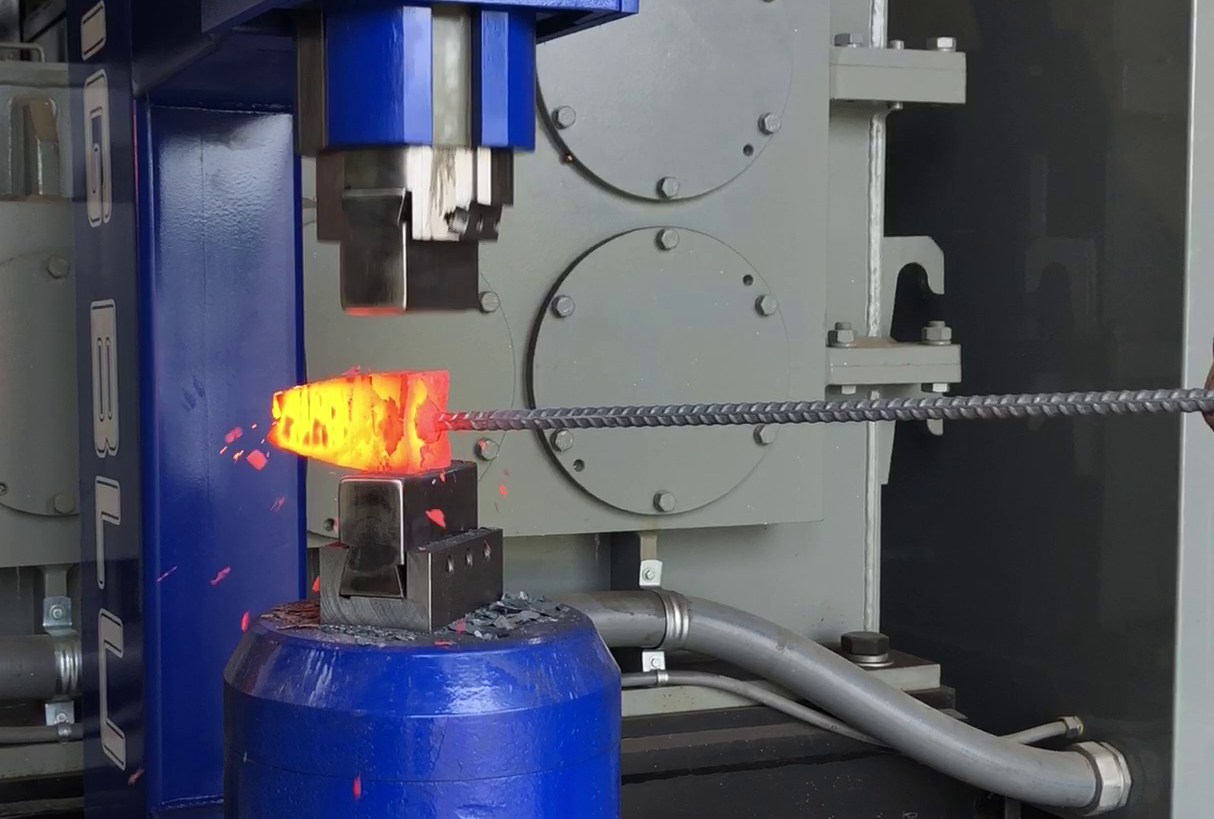
Forging Press
The hydraulic forging press at the CAVS Steel Research Center has a 50-ton capacity.
Metal Formability Tester
The CAVS facilities are equiped with an Interlaken ServoPress SP150 capable of:- 667 kN clamp force (static)
- 511 kN punch force
- 400 mm/s punch velocity
- Tooling for hole expansion, Nakajima, and Erichsen tests; option for additional (Fukui, Marciniak, Bulge die) and custom tooling
- Frame for 2-camera 3D DIC
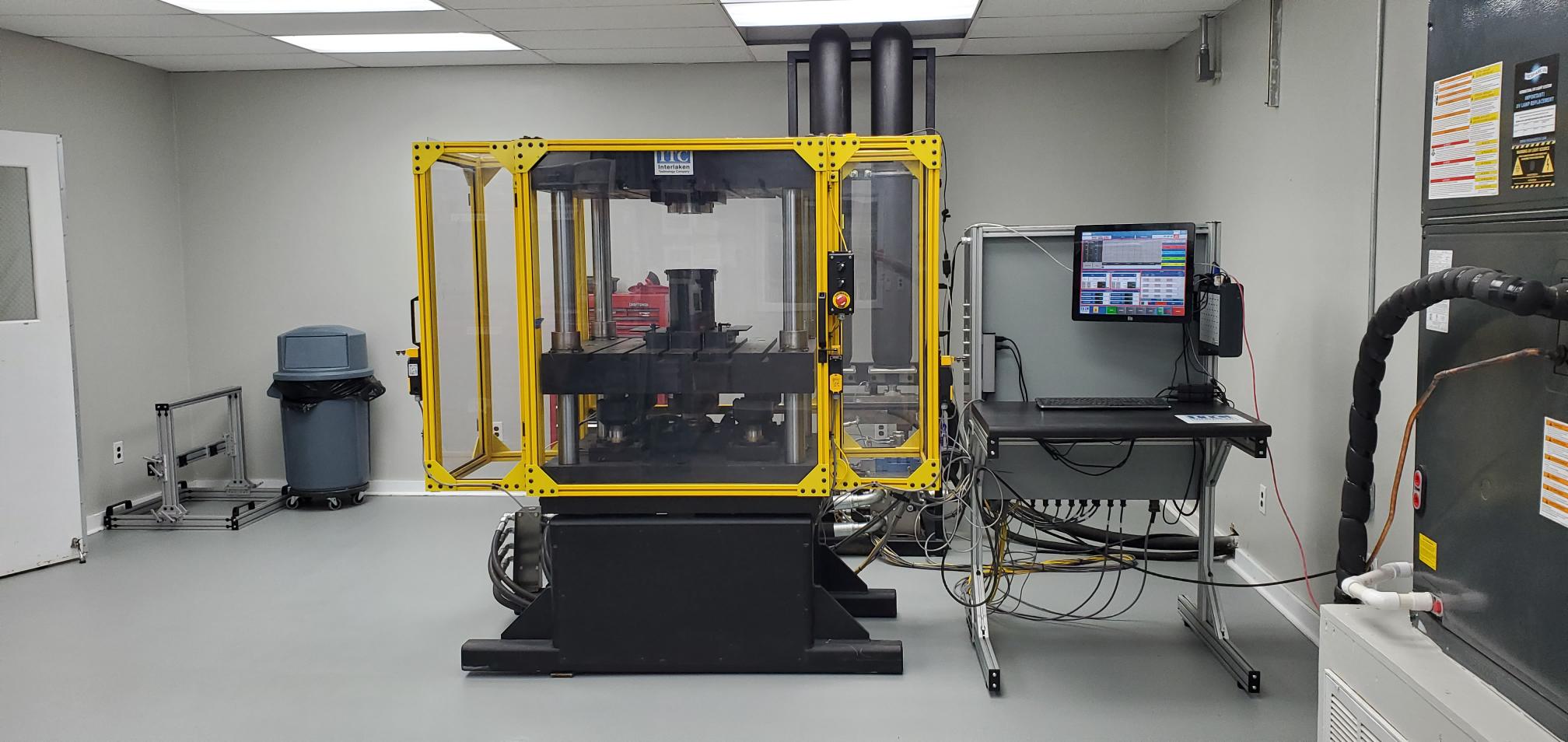
Machining and Welding
- 5-axis CNC milling machine
- CNC lathe
- Multiple manual mills and lathes
- MIG and TIG welding capability
- Sheet metal working equipment including brake, shear, and forming
- Extrusion and bending capabilities
- Wire EDM (Makino UX6)
- Sruface grinder

CNC Milling

The Haas VF-5 vertical machining center has 50" x 26" x 25" (1270 x 660 x 635 mm) xyz travels and was built utilizing all American-made cast-iron components. This machine is a rugged, medium-sized VMC that yields reliability and accuracy.
CNC Lathe

The Haas CNC SL-20 Lathe, with a max turning capacity of 10.3" x 20" and an 8.3" chuck, has a bar capacity of up to 2.0".
Omax 1515 Waterjet

The OMAX Waterjet uses abrasive particles and water pressure to cut material to different sizes and shapes. It can cut a multitude of material, up to 6 inches thick, from soft plastics, glass type of material, aluminum, carbon fiber, steel, titanium, hardened steel, and even armor plating.
Additive Manufacturing
CAVS is home to a well-equipped Additive Manufacturing Laboratory. To ensure research success at an accelerated pace, MSU and CAVS house unique resources, including AM machines, mechanical characterization equipment, full-service machine shops, a high-performance computing network/cluster and more.

click panels to expand
ABB FlexArc 250A
-
Type
Wire Arc Directed Energy Deposition (arc-DED)
-
Power Source
Fronius TPS 400i CMT or Fronius TransTig 3000 with Plasma Module 10 (PAW)
-
Build Volume
20"×20"×40"
-
Material Type
Wire
-
Materials Used
ER70S-6, ER120S-G, M250, 316L
-
Thermal Monitoring
Yes
BeAM Modulo 250
-
Type
Laser Directed Energy Deposition (DED)
-
Power Source
500W Laser with 10VX Deposition Head
-
Build Volume
16"×10"×12"
-
Material Type
Powder
-
Materials Used
Ti-6Al-4V, IN625, IN718, 316L
-
Thermal Monitoring
Yes
Renishaw AM 400
-
Type
Laser Powder Bed Fusion (L-PBF)
-
Power Source
400W Ytterbium Fibre Laser
-
Build Volume
10"×10"×12"
-
Material Type
Powder
-
Materials Used
Ti-6Al-4V, 316L, IN625
-
Thermal Monitoring
Yes
ABB IRB 2600 Robotic Weld Cell


The ABB weld cell outfitted for Wire Arc Additive Manufacturing (WAAM) uses traditional welding technologies to quickly deposit large quantities of material for larger builds. The integrated WAAM3D process monitoring end effector allows for gas shielding and temperature and arc monitoring during the process.
BeAM Modulo 250

The Modulo 250 is a 5-axis directed energy deposition (DED) laser additive manufacturing system with a 500W laser and dual powder hoppers. The DED system provides the capability to build in free space with the ability to produce functionally graded chemistries. Because of the open build area, repair of existing parts is also possible.
Renishaw AM400

The Renishaw AM400 laser powder bed fusion (L-PBF) system with a 400W laser and installed SigmaLabs thermal monitoring system is excellent for production of parts with a high level of geometric complexity or with small scale features that require the high resolution provided by the 70 nm laser spot size.
Materials Characterization
Sample Preparation
The CAVS sample preparation lab provides a safe and accurate environment for using microstructural characterization equipment to prepare materials samples for use. Specimens are mounted and then polished using a variety of manual and auto-polishing equipment. Other capabilities include etching, water-cooled cutting, and sputter coating.

Chemical Analysis
CAVS researchers collect data on detailed chemical composition to aid in developing advanced alloys. Chemical analysis capabilities include spectrometry, carbon and sulfur analysis, and energy-dispersive X-ray spectroscopy.
- Die cast or injection molding
- Standard requirements in steel or non-ferrous foundries
- Multi-matrix applications for incoming and outgoing inspection
- 18 MHz, 2.2 kW induction furnace for rapid and consistent combustion
- Integrated oxygen lance floods crucible with high-purity oxygen to promote complete combustion and improved recovery
- Individual wide-range IR detection for both carbon and sulfur
Microscopy
The microscopy facilities at CAVS include optical and scanning electron microscopes. We also have access to transmission electron microscopy through our member center, the Institute for Imaging and Analytical Technologies (I2AT). Our FEG and environmental SEMs are equipped with EBSD and EDS capabilities.

The SUPRA 40 is a general purpose high resolution FEG-SEM. Combining excellent imaging properties with analytical capabilities makes this workhorse suitable for a wide range of applications, such as materials development, failure analysis, nanotechnology and analytical applications. The large specimen chamber allows the opportunity to better configure the SUPRA 40 for specific applications without sacrificing efficiency.
- Superb resolution and image quality at low operating voltages
- Wide operating voltage range with minimal adjustments required
- Short working distance for simultaneous high resolution imaging and X-ray analysis
- High probe current and high stability better than 0.2%/h for analytical applications


The ZEISS Axiovert 200 optical microscope reaches 2500x magnification, and includes light and dark field and DIC, motorized stage, and an automatic 1000 X-ray inspection system.
Non-Destructive Examination
Non-destructive test methods such as X-ray computed tomography allow CAVS researchers to evaluate the internal and external structures of material samples. In addition to X-ray CT, we can also do surface profilometry and particle size distribution.

The Taylor-Hobson Talysurf CLI 2000 Gauge System features 3-d surface measurement down to 10 nm accuracy and 3 non-touch and one touch measurement

The Nikon XT H 225ST provides a 225 kV microfocus X-ray source with a 3 µm focal spot size.
Ultrasound
- Near-wall probe
- 5 MHz
- 64 elements
- 64 mm active aperture
Eddy Current
- 7 fully parallel channels
- Frequency: 2.5 Hz – 21 MHz (up to 3)
- Dimensions: 2" diameter × 7.5" length
- Can evaluate coatings and complex shapes, as well as hidden corrosion (independent 1st & 2nd layer material loss)
Chemical, Physical, and Local Mechanical Properties

Abilities of the Anton Paar Ultrapyc 5000 include:
- Temperature: 15 – 50°C
- Cell Sizes: 0.25 – 4.5 cm3
- Accuracy: 0.1%
- Repeatability: 0.05%
- Measures wet and dry samples measuring 10 nanometers to 3 millimeters
- +/- 0.6% of standard tolerance on these NIST-traceable polystyrene latex standards: 100 nm, 500 nm, 1.020 um, 12.01 um, 102 um & 1004 um
- +/- 0.1% coefficient of variation (COV) on these NIST-traceable polystyrene latex standards: 100 nm, 500 nm, 1.020 um, 12.01 um, 102 um & 1004 um

Hardness Measurement Tools
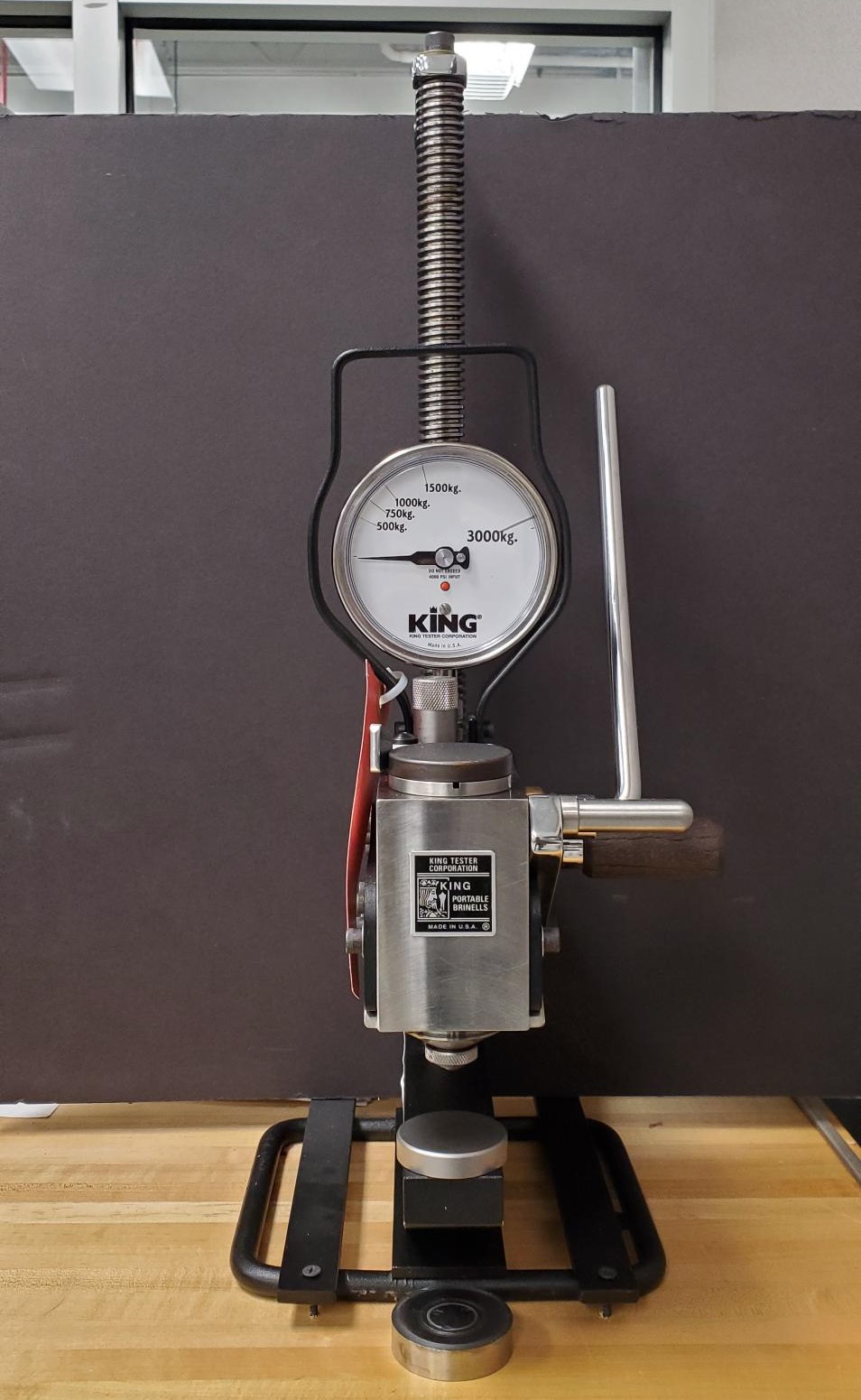
King Brinell AK-37
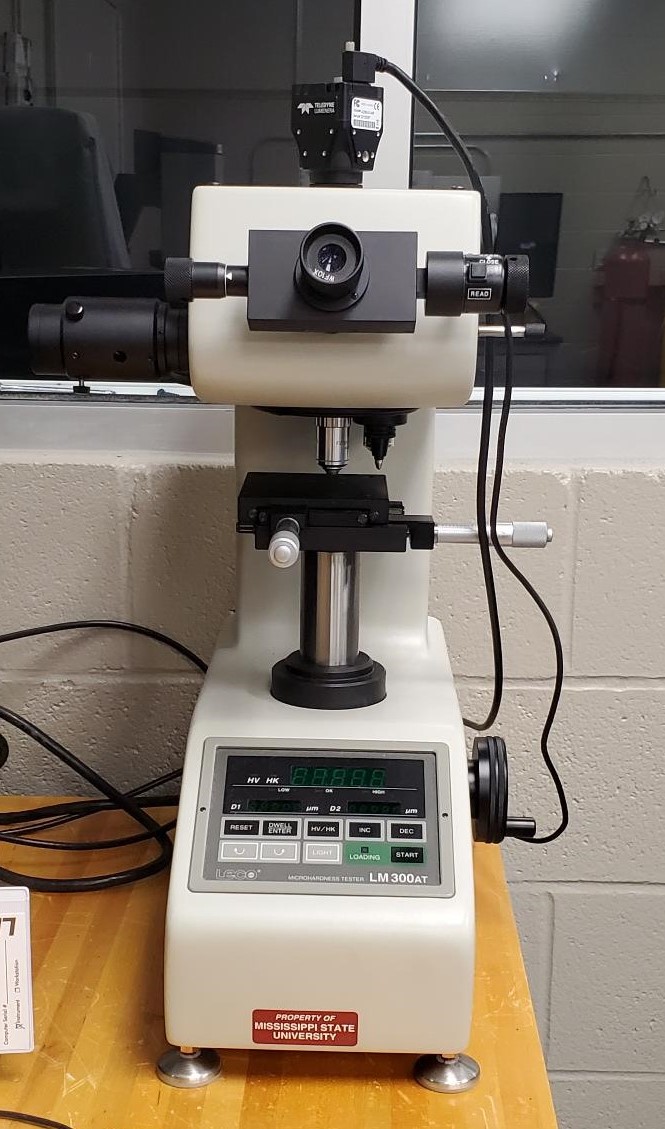
Vickers (manual): LECO LM 300
Vickers (automatic): Wilson VH3100
Rockwell: LECO LR300
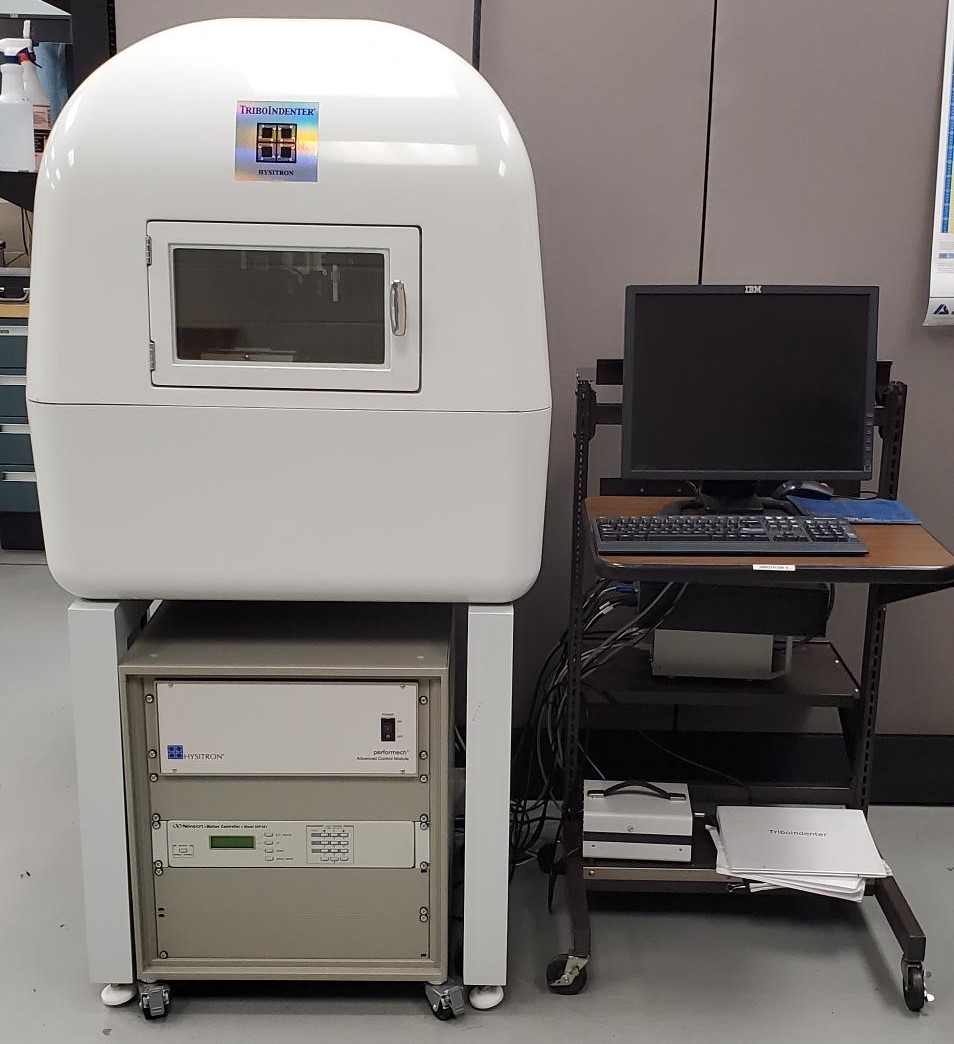
Nanoindentation: Hysitron TI950 Triboindenter
Ernst Portable Brinell
Mechanical Testing
Quasi-Static
CAVS has Instron electromechanical testing systems with 50kN and 100kN load frames that use a variety of different load cells. These machines are capable of conducting tension, compression, and flexure tests at various rates (0.001/500 mm/min) and temperatures up to 350°C. They are equipped with flat and round (Vee) jaw faces.
- MTS 810 with an axial load capacity of 100kN
- MTS LandMark with an axial load capacity of 100 kN
- MTS858 with an axial load capacity of 25 kN
- Extensometers
- Deflectometers
- Digital Image Correlation (DIC – 2D & 3D)

Hyd. Model 8850

Used for compression, tension, and torsion in axial-torsional fatigue and static testing of biomedical, advanced materials and manufactured components.
EM Model 5882

An Instron electromechanical testing system with a 100kN load frame that uses a variety of different load cells. Capable of conducting tension, compression, and flexure tests at various rates and temperatures up to 350 degrees C.
Intermediate and High Strain Rate
A critical element of understanding materials response is understanding properties over varying rates of deflection and strain. CAVS researchers have developed Split Hopkinson Pressure Bar (SHPB) high strain rate systems, deployed at multiple universities in the US, and have helped develop the first open source SHPB analysis tool for the dynamic materials community. CAVS has systems for testing both high and intermediate-rate strain response.

Split Hopkinson Pressure Bar (SHPB) used for high-strain rate testing

Intermediate-strain rate testing with high-speed camera
- Projectile slug fired at velocities ranging from 3 – 6.5 km/s at specimens from 2×2 in. up to 3×3 ft. in size
- Speed recorded with laser system
- Impact recorded with Kirana high-speed camera (up to 1,000,000 frames per second)
Gleeble
CAVS has capabilities for closed-loop thermo-mechanical simulation and testing, including high-speed deformation simulations with complete independent control of both strain and strain rate. Test variables can also include soaking times and temperatures, rolling temperature, interpass time, controlled cooling time, strain rate and amount of strain. The Gleeble at CAVS is equipped with the General Purpose, Hot Torsion, and Hydrawedge MCUs.


